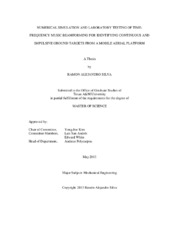| dc.description.abstract | When a microphone array is mounted on a mobile aerial platform, such as an unmanned aerial vehicle (UAV), most existing beamforming methods cannot be used to adequately identify continuous and impulsive ground. Here, numerical simulation results and laboratory experiments are presented that validate a proposed time-frequency beamforming method based on the Multiple Signal Classification (MUSIC) algorithm to detect these acoustic sources from a mobile aerial platform.
In the numerical simulations three parameters were varied to test the proposed algorithm’s location estimation performance: 1) the acoustic excitation types; 2) the moving receiver’s simulated flight conditions; and 3) the number of acoustic sources. Also, a distance and angle error analysis was done to quantify the proposed algorithm’s source location estimation accuracy when considering microphone positioning uncertainty. For experimental validation, three laboratory experiments were conducted. Source location estimations were done for: a 600 Hz sine source, a banded white noise source between 700-800 Hz, and a composite source combined simultaneously with both the sine and banded white noise sources.
The proposed algorithm accurately estimates the simulated monopole’s location coordinates no matter the excitation type or simulated trajectory. When considering simultaneously-excited, multiple monopoles at high altitudes, e.g. 50 m, the proposed algorithm had no error when estimating the source’s locations. Finally, a distance and angle error analysis exposed how relatively small microphone location error, e.g. 1 cm maximum error, can propagate into large averaged distance error of about 10 m in the far-field for all monopole excitation types. For all simulations, however, the averaged absolute angle error remained small, e.g. less than 4 degrees, even when considering a 5 cm maximum microphone location error.
For the laboratory experiments, the sine source had averaged distance and absolute angle errors of 0.9 m and 14.07 degrees from the source’s true location, respectively. Similarly, the banded white noise source’s averaged distance and absolute angle errors were 1.9 m and 47.14 degrees; and lastly, the averaged distance and absolute angle errors of 0.78 m and 8.14 degrees resulted when both the sources were simultaneously excited. | en |


